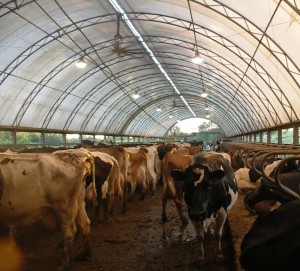06
Oct
Increase in Use of Livestock Antibiotics Linked to Superbugs. . .Again
(Beyond Pesticides, October 6, 2014) Two reports released last week add to the growing concerns surrounding the overuse of antibiotics in livestock and the corresponding public health and safety impacts of increases in antibiotic-resistant bacteria, known as superbugs.
 Researchers at the University of Texas investigated whether infections of a common and dangerous digestive tract infection, Clostridium difficile (CDI), increased during the period 2001 to 2010. The study, ”˜Deadly diarrhea’ rates nearly doubled in 10 years, examined data from the U.S. National Hospital Discharge Surveys (NHDS), which included 2.2 million CDI discharges. The analysis found that based on these data not only had CDI incidences increased, but they had nearly doubled from 4.5 percent to 8.2 percent.
Researchers at the University of Texas investigated whether infections of a common and dangerous digestive tract infection, Clostridium difficile (CDI), increased during the period 2001 to 2010. The study, ”˜Deadly diarrhea’ rates nearly doubled in 10 years, examined data from the U.S. National Hospital Discharge Surveys (NHDS), which included 2.2 million CDI discharges. The analysis found that based on these data not only had CDI incidences increased, but they had nearly doubled from 4.5 percent to 8.2 percent.
“Several factors may have contributed to the rise in CDI incidence in recent years,” said Kelly Reveles, PharmD, PhD, and lead author on the study. “Antibiotic exposure remains the most important risk factor for CDI.”
While overuse of antibiotics in humans is a part of the equation, according to the study, reducing unnecessary use of antibiotics agriculture, including conventional livestock production, has also been a primary target of concern. Because conventional livestock producers use antibiotics as growth stimulators as well as prophylactic, or subtherapeutic, treatments for infections, mostly brought on by unhealthy and overcrowded animal living conditions, the practice has increasingly come under scrutiny as untreatable infections rise in the human population.
To that point and in the face of increased scrutiny, a second report released last week by the U.S Food and Drug Administration (FDA) observed in its 2012 Summary Report on Antimicrobials Sold or Distributed for Use in Food-Producing Animals a disturbing fact: the total quantity of antimicrobial active ingredients sold or distributed for use in food-producing animals increased by 16 percent. A significant increase, this fact indicates the conventional livestock industry’s unwillingness to heed numerous warnings of scientists, environmental health advocates, and even government leaders concerning the necessity to curb overuse of antibiotics for non-illness related treatment.
Organic As a True Solution
Despite recent efforts on the part of FDA and the White House to impose new regulations and policy priorities to combat antibiotic-resistant bacteria and rein in subtherapeutic antibiotic use in livestock production, these efforts only come after intense pressure and litigation from environmental health advocacy groups and do not go far enough to address the true underlying problems of livestock production standards.
Conventional livestock production goals of quantity and bulk led to the practice of feeding subtherapeutic doses of antibiotics, beginning as early as the 1950s. It was during that time that researchers discovered that adding these drugs to livestock feed and water increased the weight gain of animals. This practice has increased as livestock production became more industrialized through the use of confined animal feeding operations (CAFOs), which often have unsanitary conditions produced by packing excessive numbers of animals into an unnatural environment and thus increasing disease risks and the spread of infection.
Under the Organic Foods Production Act (OFPA), certified USDA livestock producers cannot use growth promoters and hormones, whether implanted, ingested, or injected, and this includes antibiotics. Additionally, certified USDA Organic livestock producers cannot use subtherapeutic does of antibiotics, meaning they cannot administer low-dose antibiotic treatments that are not for the purpose of treating sick livestock. The standards also require that producers maintain living conditions that prevent infectious diseases from becoming established and adversely affecting livestock health. The National Organic Standards Board (NOSB) in the last year has stood by a decision to phase our antibiotic use in organic apple and pear production by the end of this year, after rejecting petitions by the organic apple and pear industry to extend the use of tetracycline and streptomycin -the only remaining antibiotic use in organic production.
Through supporting organic agriculture and fighting for even stronger organic standards, consumers have the power to make change happen on important issues and advance important public health and safety standards where others are lacking. For more information on what you can do to advance organic agriculture, see Beyond Pesticides’ Keeping Organic Strong webpage, which provides a number of resources for people to participate in the organic review process, including submitting comments to the National Organic Program on the upcoming National Organic Standards Board (NOSB) conference. Comments are due Tuesday, October 7, 2014!
All unattributed positions and opinions in this piece are those of Beyond Pesticides.
Sources: The New York Times, Al Jazeera











Warning: Sarcasm Alert.
In America, this is called “Science.”
In American “scientific” “agriculture”, when a mistake is repeated over and over and over — the use and “overuse” of antibiotics, GMOs, pesticides and herbicides, bizarre fertilizers, and much else [Why use them in the first place? They’re useless!] — that we call “Science.”
And we must not ever question American “Science,” especially when it earns big bucks for multinational corporations. It is unpatriotic to question corporate “Science.”
P.S. Rule of thumb: the more money a product makes, the more “scientific” is its manufacturing process.
P.P.S. Haven’t you heard? GMO Golden Rice will soon save the world!
October 7th, 2014 at 12:27 am